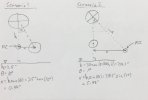The easiest and most effective scope alignment method I prefer is to first, level the rifle either off the action rails if using a conventional stock, or the bubble level on my MPA Chassis. Next, I will project the reticle on my wall mounted plum line by shining a light into the front(objective) lens in the scope and align the projected reticle with the plum line. Once aligned, torque the rings and set the scope mounted bubble level(not necessary with chassis mounted bubble level). Even with the top tier scopes, turret tops and reticle alignment should not be assumed to be true. Actual shooting/tall test alignment has proven to be 100% using this method. If the bubble is centered and the reticle plum, the bullet will fly true.....

